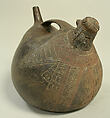Bottle, Falcon
Not on view
Inscribed designs in the form of a bird dominate this bottle. One of the vessel’s two spouts is in the form of a three-dimensional, stylized bird head. The beak faces the opposing spout. The bird’s modeled head and neck join a flat rendition of the bird’s body along the surface of the vessel. Incised lines define abstracted wings, a tail, and legs. The wings and tail are further decorated with dots and secondary lines. Alternating sections of the bird’s body are decorated with red pigment. The remaining part of the bottle is undecorated. The surface of the bottle appears to have been burnished.
The vessel’s form is reminiscent of a double spout and bridge vessel, a classic form in the Paracas culture of the south coast of Peru (700 B.C. – A.D. 1). Many Paracas double-spout vessels served as animated, musical devices, with one of the two spouts containing a whistle. The beak of the bird on this vessel is open, and it is likely that the bird would have whistled when liquid was poured out of bird’s beak.
Paracas art often emphasizes birds which may have had a form of spiritual significance. Bird depictions are frequent across a multitude of materials, including both embroidered Paracas textile fragments (e.g., MMA 33.149.25 ) and other Paracas whistling vessels (62.266.71 , 65.228.103 ). Bird-themed whistling vessels and emphasize the importance of sound and music within the Paracas ritual environment. Music was important in Andean societies, it was important in burial rituals, to communicate with ancestors, and to heal illnesses, as well as for community festivals and celebrations (see Hélène Bernier’s Timeline Essay on Andean Music). Another example of an Andean instrument from the MMA collection is a figure drum (1979.206.1097 ).
Paracas artists chose to highlight defining characteristics of animals in their depictions through incising. In this case the bird’s head, wings, and the capability to sing, have been accentuated. These incised designs were then fired and painted in a variety of colors made from iron oxides for red, yellow, and brown, copper minerals for green and blue, and silicate clays for white and black. This paint was mixed with a resin to help it bind to the ceramic surface and achieve a shine. Ceramic artists did not use potters’ wheels or molds; instead they built up the clay by hand. Likely this vessel which was constructed using a combination of coiling and paddle-and-anvil. The paddle and anvil technique uses an existing vessel or other mold to build up the base of the new vessel, then clay is added to that base to build up the sides. A wooden paddle was used to manipulate the clay and a smooth stone was used at the same time to keep the clay in place.
The Paracas culture itself is named for the peninsula on the coast of Peru where large mortuary sites have been found, the most significant of which are Paracas Cavernas and Paracas Necropolis. At these sites several hundred Paracas mummy bundles have been excavated. The dry, desert climate of the Paracas Peninsula has resulted in extraordinary preservation of these mummy bundles. A wide range of funerary offerings have been recovered from Paracas burials, including textiles, ceramics, and basketry. It is likely that this whistling vessel was included as part of a funerary offering in a Paracas mummy bundle.
Sasha Nixon, M.A. Candidate, Bard Graduate Center, 2017
References and Further Reading
Bernier, Hélène. “Birds of the Andes.” In The MET Heilbrunn Timeline of Art History. New York: The Metropolitan Museum of Art, 2000–. www.metmuseum.org/toah/hd/bird/hd_bird.htm (June 2009).
Bernier, Hélène. “Dualism in Andean Art.” In The MET Heilbrunn Timeline of Art History. New York: The Metropolitan Museum of Art, 2000–. www.metmuseum.org/toah/hd/dual/hd_dual.htm (June 2009).
Bernier, Hélène. “Music in the Ancient Andes.” In THE MET Heilbrunn Timeline of Art History. New York: The Metropolitan Museum of Art, 2000–. www.metmuseum.org/toah/hd/muan/hd_muan.htm (originally published August 2009, last revised April 2010).
Burger, Richard L. Chavin and the Origins of Andean Civilization. London: Thames and Hudson, 1995.
DeLeonardis Lisa. “Encoded Process, Embodied Meaning in Paracas Post-Fired Painted Ceramics.” In Making Value, Making Meaning: Techné in the Pre-Columbian World, edited by Cathy Costin, pp. 129-166. Washington D.C.: Dumbarton Oaks Research Library and Collections, 2016. Druc, Isabelle C. "Ceramic Diversity in Chavín De Huantar, Peru." Latin American Antiquity 15, no. 3. (2004): 344-63.
Eerkens Jelmer W, et al. “Iron Isotope Analysis of Red and Black Pigments on Pottery in Nasca, Peru.” Archaeological and Anthropological Sciences 6 (2014): 241-254.
LaGamma, Alisa, et al. “The Nelson A. Rockefeller Vision: Arts of Africa, Oceania, and the Americas.” The Metropolitan Museum of Art Bulletin LXXII(1): Summer 2014.
Pillsbury Joanne. “The Pan-American: Nelson Rockefeller and the Arts of Ancient Latin America.” The Metropolitan Museum of Art Bulletin 72:1 (2014): 18-27. Proulx Donald A. “Paracas and Nasca: Regional Cultures on the South Coast of Peru.” In Handbook of South American Archaeology, edited by Helaine Silverman and William Isbell, pp. 563-584. Spring, 2008.
Sawyer Alan. Ancient Peruvian Ceramics: The Nathan Cummings Collection. New York: The Metropolitan Museum of Art, 1966.
Silverman Helaine. “The Paracas Problem: Archaeological Perspectives.” In Paracas Art and Architecture: Object and Context in South Coastal Peru, ed. Anne Paul. Des Moines: University of Iowa Press (1991): 348-415.
Stone Rebecca. Art of the Andes: From Chavín to Inca. 3rd edition. New York: Thames & Hudson World of Art Series, 2012.
Vaughn Kevin J. and Hector Neff. “Moving Beyond Iconography: Neutron Activation Analysis of Ceramics from Marcaya, Peru, an Early Nasca Domestic Site.” Journal of Field Archaeology 27:1 (2000): 75-90.
Due to rights restrictions, this image cannot be enlarged, viewed at full screen, or downloaded.

